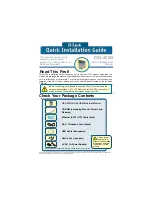
Q-Flex Satellite Modem Installation and Operating Handbook
11-1
Chapter 11 Fault Messages
The following table lists all of the modem faults along with a description of what the fault
means. It also describes relevant checks the operator might make to try to eliminate the
fault condition. Note that the text shown in the table will be displayed in full on the web user
interface and in the system log but may appear in an abbreviated format on the front panel
LCD display due to space considerations.
The acronyms used to define the actions taken on each fault occurring are as follows:
Actions: Relays
U:
Prompt unit fault relay.
T:
Prompt traffic fault relay.
D:
Deferred alarm relay.
Actions: To Terrestrial
TA:
AIS in selected timeslot if the Insert MUX is active or AIS over all data if not in Insert
mode. If Insert mode is active and the user control thin route spoofing is on, then AIS is
forced over the whole PCM bearer, not just the selected timeslots to spoof full bearer
connectivity when passed over a Thin Route satellite circuit.
TB:
Frame Backward alarm.
TC:
AIS forced in the G.732 CAS ‘abcd’ signalling nibble.
TD:
Force a fixed value in the G.732 CAS
‘abcd’ signalling nibble.
TE:
Multiframe Backward alarm in IBS/SMS TS16/TS48 over satellite.
Actions: To Satellite
SA:
AIS framed and scrambled and subject to RS coding if active.
SB:
Frame Backward alarm.
SC:
AIS in CAS signalling carried in IBS/SMS TS16/TS48 over satellite.
Actions: Other
CM:
Carrier mute.
TF:
Tx flow control CTS (Clear To Send) line is switched off.
RF:
Rx flow control RR (Receive Ready) line is switched off.
















































